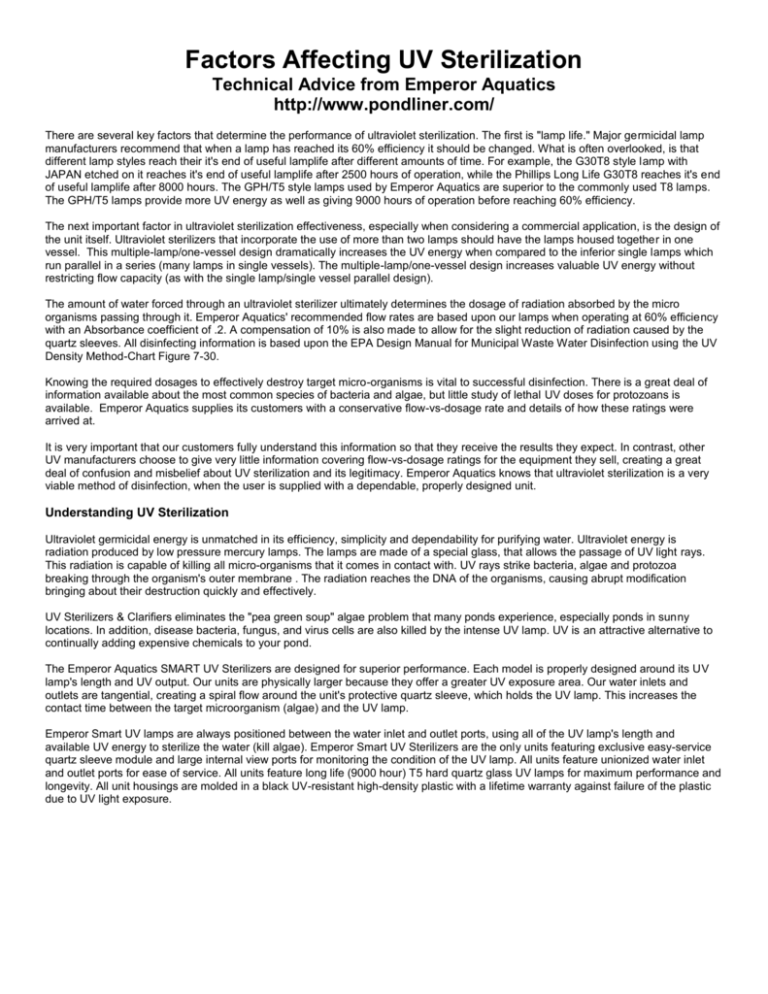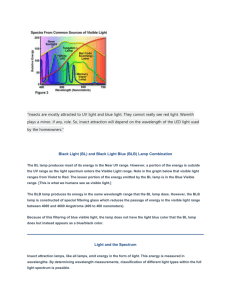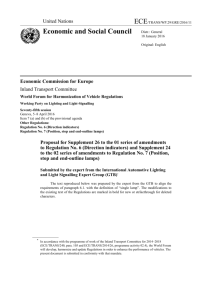uvfilter - Chapters.MarsSociety.org
advertisement

Factors Affecting UV Sterilization Technical Advice from Emperor Aquatics http://www.pondliner.com/ There are several key factors that determine the performance of ultraviolet sterilization. The first is "lamp life." Major germicidal lamp manufacturers recommend that when a lamp has reached its 60% efficiency it should be changed. What is often overlooked, is that different lamp styles reach their it's end of useful lamplife after different amounts of time. For example, the G30T8 style lamp with JAPAN etched on it reaches it's end of useful lamplife after 2500 hours of operation, while the Phillips Long Life G30T8 reaches it's end of useful lamplife after 8000 hours. The GPH/T5 style lamps used by Emperor Aquatics are superior to the commonly used T8 lamps. The GPH/T5 lamps provide more UV energy as well as giving 9000 hours of operation before reaching 60% efficiency. The next important factor in ultraviolet sterilization effectiveness, especially when considering a commercial application, is the design of the unit itself. Ultraviolet sterilizers that incorporate the use of more than two lamps should have the lamps housed together in one vessel. This multiple-lamp/one-vessel design dramatically increases the UV energy when compared to the inferior single lamps which run parallel in a series (many lamps in single vessels). The multiple-lamp/one-vessel design increases valuable UV energy without restricting flow capacity (as with the single lamp/single vessel parallel design). The amount of water forced through an ultraviolet sterilizer ultimately determines the dosage of radiation absorbed by the micro organisms passing through it. Emperor Aquatics' recommended flow rates are based upon our lamps when operating at 60% efficiency with an Absorbance coefficient of .2. A compensation of 10% is also made to allow for the slight reduction of radiation caused by the quartz sleeves. All disinfecting information is based upon the EPA Design Manual for Municipal Waste Water Disinfection using the UV Density Method-Chart Figure 7-30. Knowing the required dosages to effectively destroy target micro-organisms is vital to successful disinfection. There is a great deal of information available about the most common species of bacteria and algae, but little study of lethal UV doses for protozoans is available. Emperor Aquatics supplies its customers with a conservative flow-vs-dosage rate and details of how these ratings were arrived at. It is very important that our customers fully understand this information so that they receive the results they expect. In contrast, other UV manufacturers choose to give very little information covering flow-vs-dosage ratings for the equipment they sell, creating a great deal of confusion and misbelief about UV sterilization and its legitimacy. Emperor Aquatics knows that ultraviolet sterilization is a very viable method of disinfection, when the user is supplied with a dependable, properly designed unit. Understanding UV Sterilization Ultraviolet germicidal energy is unmatched in its efficiency, simplicity and dependability for purifying water. Ultraviolet energy is radiation produced by low pressure mercury lamps. The lamps are made of a special glass, that allows the passage of UV light rays. This radiation is capable of killing all micro-organisms that it comes in contact with. UV rays strike bacteria, algae and protozoa breaking through the organism's outer membrane . The radiation reaches the DNA of the organisms, causing abrupt modification bringing about their destruction quickly and effectively. UV Sterilizers & Clarifiers eliminates the "pea green soup" algae problem that many ponds experience, especially ponds in sunny locations. In addition, disease bacteria, fungus, and virus cells are also killed by the intense UV lamp. UV is an attractive alternative to continually adding expensive chemicals to your pond. The Emperor Aquatics SMART UV Sterilizers are designed for superior performance. Each model is properly designed around its UV lamp's length and UV output. Our units are physically larger because they offer a greater UV exposure area. Our water inlets and outlets are tangential, creating a spiral flow around the unit's protective quartz sleeve, which holds the UV lamp. This increases the contact time between the target microorganism (algae) and the UV lamp. Emperor Smart UV lamps are always positioned between the water inlet and outlet ports, using all of the UV lamp's length and available UV energy to sterilize the water (kill algae). Emperor Smart UV Sterilizers are the only units featuring exclusive easy-service quartz sleeve module and large internal view ports for monitoring the condition of the UV lamp. All units feature unionized water inlet and outlet ports for ease of service. All units feature long life (9000 hour) T5 hard quartz glass UV lamps for maximum performance and longevity. All unit housings are molded in a black UV-resistant high-density plastic with a lifetime warranty against failure of the plastic due to UV light exposure. What is UV Sterilization? http://www.marineandreef.com/Info/uvsterilization.html What exactly is UV Sterilization? It's actually a very simple process for removing (or filtering) unwanted free floating bacteria and parasitic organisms, like ich, out of your water by passing the water through Ultra Violet (UV) light. The UV light affects the living cells by altering the structure of the cell's nuclear material. The end result is the organisms die, erradicating your aquarium water of these unwanted nuisances. UV can also alter the structure of some dissolved chemical compounds, so you do not want to run your UV light filter when treating your aquarium with any drug or chemical medication. Because many of the inhabitants of a reef system are dependent on good types of micro-organisms for food sources, you may not want to run a UV filter in this type of aquarium. If you decide you need a UV filter, the effectiveness of this filter can be hindered if: The water passes too fast past the bulb There is light blockage The bulb becomes old Whether you choose the tray, wet bulb or dry bulb UV set-up, the bulb should be changed at least every 6 months for the best results. UV light can be damaging to the human eye so DO NOT look into the bulb. Always unplug your unit when working on it to prevent possible shock if it breaks and gets wet. Choosing a UV Sterilizer 4-8 watt units are good for marine aquarium purposes for 20-40 gallon tanks. For 55-100 gallon tanks, 15-watt units are pretty common. For larger tanks like a 250 gallon a 40-watt unit is good. UV light ranges from 200 to 300nm. This is the effective kill range for most aquarium pests. For most aquariums, you will need 3-4 watts per gallon of tank water. For proper irradication of microorganisms, contact time is everything. Therefore, we recommend that you use a pump that delivers about 1/2 the capacity recommended by the UV manufacturer. About Quartz Lamps Low Pressure mercury type lamps are best suited to germicidal action because the primary radiation generated by these lamps consists almost exclusively of a special wave length of 254 n meters, which is close to maximum peak germicidal effectiveness wave length of 265 n meters. (The germicidal effectiveness curve is between 250 n meters and 280 n meters, with the peak at 265 n meters.) This gives the low pressure mercury type lamps an exceptional 40% uv energy efficiency rate between input watts to uv output watts. Lamp life: Low pressure mercury types typically last from 2500 to 9000 hours depending on styles. Medium and high pressure types typically last 1000 hours depending on use. Lamp length: The length of the uv lamp used relates to the time exposure between the microorganism and the uv radiation energy being produced by the lamp. The longer the lamp, the longer the contact time. The next important factor in ultraviolet sterilization effectiveness, especially when considering application, is the design of the uv contacting vessel itself. Ultraviolet sterilizers which incorporate the use of more than two (2) lamps should have the lamps housed together in one vessel. The multiple lamp/one-vessel design dramatically increases the uv energy as compared to the inferior singlelamp/single vessel parallel design (many lamps in single vessels). The multiple-lamp/one vessel design increases valuable uv energy without restricting flow capacity (as does the single lamp/single vessel parallel design). Flow Rates: The amount of water forced through an ultraviolet sterilizer ultimately determines the dosage of radiation absorbed by the microorganisms passing through it. Emperor Aquatic's recommended flow rates are based upon when lamps are operating at their 60% end of life efficiency (not 100% full efficiency like most manufacturers). Watertight Design: A two-piece watertight design improves safety while increasing the versatility of the unit. It can even be buried inmulch out of sight for pond applications. Servicing is quick and easy because of the bulbs four-pin single ended electrical connection. Address: 11034 W. Ocean Air Dr., Suite #150, San Diego, CA 92130 Phone and Fax: (858) 481-0267 Email: sales@marineandreef.com Office Hours: M-F 8:30-4:30 (Pacific Time) marineandreef.com is owned and operated by Vox Global Ultraviolet Sterilizers http://www.actwin.com/fish/mirror/filters.html High intensity ultraviolet light destroys the DNA in living cells and can be an effective means to control living pathogens. The most effective UV light is the high energy UV(C) light roughly at the wavelength of 250 Angstroms. To be effective, UV Sterilization (UVS) must expose the pathogens to high enough light intensity for a long enough period of time. Martin Moe cites 35,000 to 100,000 microwatts per second per square centimeter as the norm, which works out to roughly 10 to 25 gallons per hour per watt (or less for units not operating at peak efficiency). Common problems which can reduce efficiency and kill rate are: 1. Allowing the water to flow too fast past the UV light. 2. Light blockage due to a build up of salt deposits or bacterial slime on the bulb. 3. Fading of the light due to age of the bulb (which typically have a six month life.) The same property of this light that kills germs can damage your eyes, and special care MUST BE TAKEN to avoid direct or indirect eye contact with this light. [This is especially serious because the damage occurs inside your eyes before you feel any pain. Too many people have already damaged their eyes in this way!] The UV(C) light does not penetrate water very well, so to be effective, UV Sterilizers commonly position the UV bulb close to the water which also can pose a risk of electrical shock should the bulb break, etc. There are three types of UV Sterilizers: 1. Tray type. With UV bulbs suspended in a reflecting fixture over a shallow tray of slow flowing water. Benefits: easily cleaned, can be cheap, can be made large enough for commercial applications. Problems: safety risks to your eyes, too large and awkward for many home uses. 2. Tube type, wet bulb. Tube types have the benefit of exposing all sides of the UV tube to water with no reflector. The water passes directly past the bulb which is mounted in a waterproof tube. Benefits: cheap, compact and effective. Problems: difficult to clean the slime accumulations from the bulb, safety risks due to electrical shock. 3. Tube type, dry bulb. Similar to above, but the UV tube is surrounded by a quartz tube [glass blocks UV(C) light] insulating it from the water. These are more expensive and probably safer. Changing the light bulb is easier and dry bulb tube types can have an internal device to wipe slime from the quartz tube. Some of these types come with sensors to monitor the intensity of the light to let you know when to replace/clean the bulb. etc.




